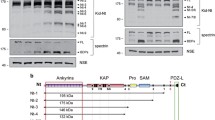4. Conclusion
The data presented, demonstrate for the first time PEP turnover of HN by a limited postcysteine as well as the expected post-proline proteolysis demonstrated in cell extract resulting in the inactivation of this potentially apoptosis-related factor. These findings lead to the hypothesis of a PEP-mediated control of HN homeostasis maintaining neuronal cell survival. This implicates a novel use of PEP inhibitors potentially preventing intracellular HN digestion. Consequently, PEP-inhibition might be a new target for apoptosis prevention.
This study further uncovered a so far unknown enzymatic specificity for a post-cysteine cleavage of the mammalian exopeptidases DP2, DP4, DP8 and DP9 and the endopeptidase PEP.
Access this chapter
Tax calculation will be finalised at checkout
Purchases are for personal use only
Preview
Unable to display preview. Download preview PDF.
Similar content being viewed by others
References
Bär J, Weber A, Hoffmann T, Stork J, Wermann M, Wagner L, Aust S, Gerhartz B and Demuth HU, 2003, Characterisation of human dipeptidyl peptidase IV expressed in Pichia pastoris. A structural and mechanistic comparison between the recombinant human and the purified porcine enzyme. Biol Chem. 384: 1553–1563.
Dresdner K, Barker LA, Orlowski M, and Wilk S, 1982, Subcellular distribution of prolyl endopeptidase and cation-sensitive neutral endopeptidase in rabbit brain. J Neurochem. 38: 1151–1154.
Goossens F, De Meester I, Vanhoof G and Scharpe S, 1996, Distribution of prolyl oligopeptidase in human peripheral tissues and body fluids. Eur J Clin Chem Clin Biochem. 34: 17–22.
Guo B, Zhai D, Cabezas E, Welsh K, Nouraini S, Satterthwait AC and Reed JC, 2003, Humanin peptide suppresses apoptosis by interfering with Bax activation. Nature. 423: 456–461.
Hashimoto Y, Niikura T, Tajima H, Yasukawa T, Sudo H, Ito Y, Kita Y, Kawasumi M, Kouyama K, Doyu M, Sobue G, Koide T, Tsuji S, Lang J, Kurokawa K and Nishimoto I, 2001, A rescue factor abolishing neuronal cell death by a wide spectrum of familial Alzheimer’s disease genes and Abeta. Proc Natl Acad Sci USA. 98: 6336–6341.
Irazusta J, Gil J, Ruiz F, Agirregoitia N, Casis L and Silveira PF, 2002, Effect of the disruption of body fluid balance on pyroglutamyl aminopeptidase (Type-1) in rat brain structures. Neuropeptides. 36: 333–340.
Kariya S, Takahashi N, Hirano M and Ueno S, 2003, Humanin improves impaired metabolic activity and prolongs survival of serum-deprived human lymphocytes. Mol Cell Biochem. 254: 83–89.
Katsube N, Sunaga K, Aishita H, Chuang DM and Ishitani R, 1999, ONO-1603, a potential antidementia drug, delays age-induced apoptosis and suppresses overexpression of glyceraldehyde-3-phosphate dehydrogenase in cultured central nervous system neurons. J Pharmacol Exp Ther. 288: 6–13.
Mentlein R, 1988, Proline residues in the maturation and degradation of peptide hormones and neuropeptides. FEBS Lett. 234: 251–256.
Polgar L, 1994, Prolyl oligopeptidases. Methods Enzymol. 244: 188–200.
Schulz I, Gerhartz B, Neubauer A, Holloschi A, Heiser U, Hafner M and Demuth HU, 2002, Modulation of inositol 1,4,5-triphosphate concentration by prolyl endopeptidase inhibition. Eur J Biochem. 269: 5813–5820.
Shishido Y, Furushiro M, Tanabe S, Shibata S, Hashimoto S and Yokokura T, 1999, Effects of prolyl endopeptidase inhibitors and neuropeptides on delayed neuronal death in rats. Eur J Pharmacol. 372: 135–142.
Sponne I, Fifre A, Koziel V, Kriem B, Oster T and Pillot T, 2004, Humanin rescues cortical neurons from prionpeptide-induced apoptosis. Mol Cell Neurosci. 25: 95–102.
Welches WR, Brosnihan KB and Ferrario CM, 1993, Acomparison of the properties and enzymatic activities of three angiotensin processing enzymes: angiotensin converting enzyme, prolyl endopeptidase and neutral endopeptidase 24.11. Life Sci. 52: 1461–1480.
Author information
Authors and Affiliations
Editor information
Editors and Affiliations
Rights and permissions
Copyright information
© 2006 Springer Science+Business Media, Inc.
About this paper
Cite this paper
Bär, J.W. et al. (2006). Prolyl Endopeptidase Cleaves the Apoptosis Rescue Peptide Humanin and Exhibits an Unknown Post-Cysteine Cleavage Specificity. In: Lendeckel, U., Reinhold, D., Bank, U. (eds) Dipeptidyl Aminopeptidases. Advances in Experimental Medicine and Biology, vol 575. Springer, Boston, MA . https://doi.org/10.1007/0-387-32824-6_11
Download citation
DOI: https://doi.org/10.1007/0-387-32824-6_11
Publisher Name: Springer, Boston, MA
Print ISBN: 978-0-387-29058-4
Online ISBN: 978-0-387-32824-9
eBook Packages: Biomedical and Life SciencesBiomedical and Life Sciences (R0)




